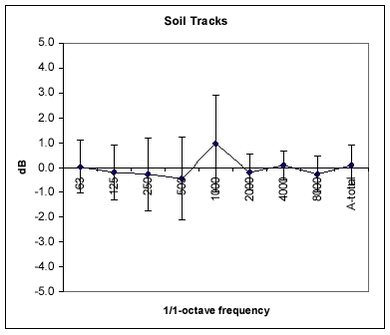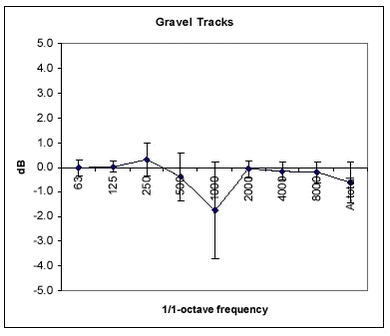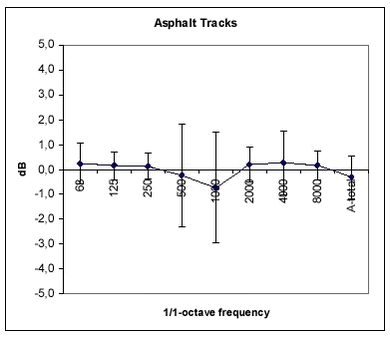Motor Racing Vehicles - Measurement Methods
5 Development methodology5.1 General5.2 Analysis of existing data 5.3 Evaluation of new declaration ground correction 5.4 Evaluation of new monitoring ground correction 5.1 GeneralBased on the functional requirements, the following basic features were initially evaluated and determined.
In order to minimise the amount of new measurements in the project, the existing pool of noise emission data was utilised. Ref. 1-3 contain a comprehensive amount of data, and these data were used as a basis for the development of the new methods. As described in ref. 1, the existing declaration method is based on Leq measurements, and gives the immission relevant sound power level per 1/3-octave bands. It was therefore found that this method would be the best basis for the new declaration method. However, determination of 1/3-octave noise emission is found to be an unnecessary complication, as the present relevant prediction models only utilise 1/1-octave bands anyway. The crucial point in the existing method is the ground correction, which is a computed value integrated over the segment of the track where the noise is measured. Further, the ground correction is based on specific knowledge of the acoustic flow resistance of the ground in question. This is considered to be a too complicated procedure for more widespread use of this method. The main point of the development methodology has therefore been development of a less complicated ground correction term, while reasonably maintaining the accuracy of the existing method. 5.2 Analysis of existing dataBasically, the existing declaration method can be expressed as: LW = Leq + K – ΔLg, where ΔLg is the ground correction term and K represents a combination of other parameters such as distance, driving speed, etc. In order to investigate the impact of a new less complicated ground correction term, the following analysis was performed for the noise emission data from ref. 1-3:
To evaluate the quality of the alternative ground correction terms, the new sound power levels were compared with the original levels. The initial approach was to calculate new ground corrections according to the analytical method given in ref. 4 for three types of racetracks. This method gives the point-point ground correction, whereas the original ground correction integrates the acoustic properties of the surface between the complete driving path and the microphone position. As a basis for the alternative ground correction terms, the following three acoustic ground properties were assumed in the investigation.
The point to point ground corrections were determined in 1/1-octave bands according to ref. 4 for the transmission path corresponding to the shortest distance between source and microphone. The result of the initial noise emission analyses show, however, that no acceptable agreement with the original noise emission could be achieved using the analytical point-point ground correction from ref. 4. There was a general trend towards underestimating the noise emission (total LWA) with up to 4 dB. It is our evaluation that this disagreement is caused by the different approaches between the two ground corrections. The original correction is determined as an integrated value over the same integration path as the noise (Leq) is measured and integrated. The point-point ground correction from ref. 4 is based on a restricted part of the noise transmission path only, and may therefore differ from a ground correction based on the complete transmission path. Therefore an alternative approach was used. The ground correction was defined for three racetrack types, as those ground correction values that empirically gave the best agreement with the original measurements. Those ground corrections are fixed values that depend only upon the type of racetrack and not on the actual geometry of the measurements. This approach has the following advantages and disadvantages:
As agreement with the original measurements had the highest priority, the steering committee of the project determined to support the definition approach, even if this means that the normal analytical procedure for determining the ground correction cannot be used in connection with motor racing vehicles. It was, however, not considered acceptable to support a procedure that in general underestimates the noise emission. The definition approach resulted in the ground corrections shown in Table 1. 5.3 Evaluation of new declaration ground correctionFigure 1 to 3 shows a summary of the difference between the original sound power levels and the levels determined with the alternative ground corrections. This analysis is based on ref. 1-3, which comprises a number of motocross-speedway- and karting racetracks. Figure 1.
Figure 2. Figure 3.
As expected, the average deviation between the original noise emission and the noise emission obtained with the new ground corrections is small. This is a consequence of the definition approaches. Thus, the uncertainty contribution from the ground correction is estimated at 1-2 dB. 5.4 Evaluation of new monitoring ground correctionIt was initially decided that Leq is the best available descriptor for declaration purposes, as Leq implicitly averages the noise emission from the individual vehicles on an energy basis, thus creating the noise emission for an average vehicle. For the monitoring method, however, a descriptor characterising the noise emission of each individual vehicle is necessary. Therefore LpAmax F was selected for this purpose. In order to formulate the ground correction for the monitoring method, supplementary measurements were performed for Speedway, Cross and Karting. The purpose of the measurements was to establish the relationship between sound power levels and maximum sound pressure levels for typical racing vehicles under realistic racing conditions, as these values were not included in the existing pool of data. Due to budget and time constraints only a limited number of measurements were possible. The number of measurements and the representativity of the tested vehicles do not fulfil the recommendations for normal declaration measurements. The measurement conditions and results are described in Appendix. For each type of vehicle, the following analyses were performed: First the sound power level was determined using the declaration method (Leq) and the ground corrections determined by the definition approach. Then this sound power level was combined with the simultaneously measured LpAmax F – values in order to determine the ground corrections for the monitoring method: 1) Declaration: LW = Lq,t + 10 log(4vat) - ΔLgd – 10 log N where v is the driving speed, t is the integration time, a is the average minimum distance between vehicle and microphone, N is the number of passing vehicles in the integration time, and ΔLgd is the ground correction given in table 1. 2) Monitoring: LWA = LpAmax F + 10 log (4 ð a2) - ΔLg The A-weighted declaration values were determined using expression 1. These values were then inserted in expression 2 together with the measured LpAmax F levels. Then the monitoring method ground corrections ΔLg were determined from expression 2 (the monitoring method is restricted to total A-weighted levels). These values are shown in Figure 2. One may argue that the values in Table 2 theoretically are expected to be in the interval 8 – 11 dB instead of the actual interval 6.7 – 12.8 dB. It shall, however, be borne in mind, that the theoretical 8 –11 dB correction refers to a point to point sound propagation situation for omnidirectional point sources, while the values in Table 2 implicitly refers to an integrated sound transmission path for sound sources that are not necessarily omnidirectional. Thus, there is no direct link between the two procedures and corrections. |


